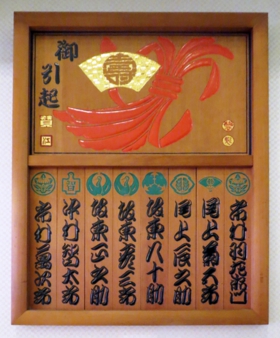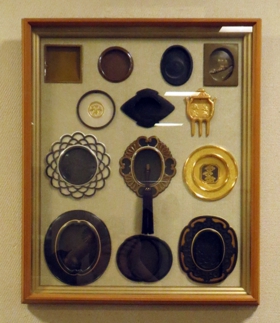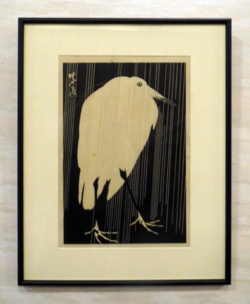Q: Could you tell me about recent activities of "Taito-ku Dentokogei Shinko-kai (traditional crafts promotion association)" in Taito City? What kind of industry's craftsmen have participated in the association?
We have used the Edo Shitamachi Traditional Crafts Museum as a base of our activities. Under present circumstances, it is difficult for craftsmen to think for themselves and change the way traditional crafts are dealt. Although the sunlight does not come into the gallery, exhibits fade over time. When bamboo blinds, silverware and copperware are exposed to air, they change color. Therefore, exhibits are occasionally replaced. It is a good opportunity to devise a way to display items, and to come up with new products. Although products we have made are called "traditional crafts," they are daily commodities rather than artistic crafts, so we should devise and create crafts that go with the times.
Basically, 26 traditional crafts out of 40 designated by Tokyo are produced in Taito City, but that is not always true because industry types that members of the association are involved have occasionally been changed. Murayama Oshima Tsumugi, Honba Kihachi-j and Tama-ori are not produced in Taito City. To dye textiles, water is necessary. For example, the Shakujii River flows in Ochiai, Shinjuku City, so many textile dyeing studios exist along the river. In the past, there was a river in Yanaka, Taito City, and the area along the river was called "Aizome-machi," literally meaning indigo-dyeing town, so I think there were some textile dyeing studios in the area.
Q: In Taito City, some craftsmen make pouches. Does nobody make dyed fabrics that are materials for pouches in Taito City?
Pouches began to be made in relatively-recent years in Taito City. Although 26 items are designated as traditional crafts, some are made as family businesses, and others are made by young craftsmen who recently participated in the association. It is often said that traditional crafts disappear if there is no successor. However, if there is a demand for crafts, they do not disappear. If there is a demand, craftsmen can stay in business, and successors can be trained.
It is concerned that there in no successor at shopping districts with many closed stores. For example, it is impossible for a family-run store to significantly boost sales. It is practically impossible to run the store with two generations when their children are grown up. Therefore, as a matter of course, there is no successor. In Taito City, many family-run studios have been closed, and traditions are lost, but some people want to take over those studios. Although some traditional craftsmen take apprentices instead of having their sons take over their businesses, it is difficult for apprentices to become independent and make livings. It might be good to make traditional crafts as a hobby, but for young people graduated from art schools or other specialty schools, I think it might be better for them to do other jobs. If they want to make traditional crafts by all means, they can do so, but they should make up their minds. Although young people begin to make traditional crafts, they tend to quit in 4-5 years when they realize that it is difficult to make livings.
I think an instinctive urge to make something is not necessary, but inclinations to be "greedy" and do carpentry work are needed. An inclination to be "greedy" implies a mind that spontaneously does something. For example, if you find 100,000 yen on a street, you pick it up whether other people see you or not. An inclination to do carpentry work implies a mind that wants to create and complete something by yourself. These minds are different depending on each individual. Everybody wants to create something. Therefore, we have demonstrated how to make traditional crafts and offered workshops as activities of the traditional crafts promotion association in Taito City at various places, including museums in Ueno, elementary and junior high schools and "Asakusa Bunka Kanko Center," or Asakusa Culture Tourist Information Center, in Taito City. We have also conducted similar activities in other cities and towns, including Osaki City in Miyagi Prefecture, which is a sister city to Taito City, Aizumisato-cho and Minamiaizu-cho in Fukushima Prefecture, and Murayama City in Yamagata Prefecture, which are friendship cities. Children are delighted with those activities.(continued in the right column)
Q: It is like a traditional crafts revival movement, isn't it? Do you have an intention to enlarge the association? I once interviewed people involved in the bamboo industry in Yatsushiro City, Kumamoto Prefecture. The traditional craft industry was prosperous in the region. I heard that they tried to improve productivity by replacing bamboo with plastic under the nation's guidance in the postwar period. Then, many products began to be imported from China. So, they made an attempt to recover techniques of traditional bamboo crafts, but the lost techniques could not be recovered. As a result, many craftsmen quit their jobs. In the area around Beppu, which is a health resort, traditional bamboo crafts are left to some extent, but even though there is a plenty of bamboo, it is impossible to make bamboo crafts again without skills.
Although it is not a traditional crafts revival movement, you can find products and stores everywhere when you visit local areas. Also, there is every kind of food. However, there are not traditional crafts. Traditional crafts are crafts for everyday life, and craftsmen make their livings by making them. If there is no demand for traditional crafts, craftsmen stop making them. Therefore, it is not necessary to enlarge the association as an organization or company. We do not want anything but to make livings with traditional crafts we have made. Certainly, bamboo crafts have been affected by the emergence of new materials, such as plastic. I think the reason bamboo crafts have still been produced in Taito City is that there is continuous demand for the crafts. Nowadays, we have visitors from far away, who come to this area not just because it is a tourist spot. Cutting instruments that are displayed here become rusty, so we sell the instruments at low prices. Although it is not an on-site sale, we have also held auctions twice a year for nearly 10 years. It was just a casual idea at first, but we have held the auctions twice a year as business. Since items that are difficult to obtain can be purchased at reasonable prices, the auctions go down well with people. Instead of buying expensive crafts, people can purchase good crafts at low prices.
The difference between traditional crafts we have made, that are to say, crafts made in Japan, and crafts made in other countries is that our crafts are not disposable products. Out crafts can be used for a long time. The reason there are many lines of business and products is that one type of product is produced for a single purpose. For example, many types of kitchen knives, including a broad-bladed carving knife, a slender kitchen knife for slicing raw fish, and a kitchen knife for removing clams from the shells, have been produced. Also, there are many types of cookpots, including a old-style pot, a milk pan, a frying pan and a single-handled pan. I think this is specific to Japan. There are not so many countries that can produce one type of product for a single purpose. Overseas visitors and those who are interested in traditional crafts occasionally visit us, and praise our products, saying that, in any case, Japanese products are excellent and carefully made.
Q: Are there some people who became interested in traditional crafts and have settled in this area? Aldo, have you ever given guidance on how to make traditional crafts, cooperating with any organization?
There is a few people who have newly settled in this area, but the number of people who are interested in traditional crafts and begin to make them has increased. We have also accumulated experience, so we have become fairly good at guiding people at workshops. We had cooperated with Tokyo University of the Arts for 3 years. Ryohei Miyata, the president of Tokyo University of the Arts, took a leadership role in the cooperative activities. It was very interesting. Somebody created a dress out of bamboo blinds. Ideas of young people were great. When we explained about techniques and procedures to make crafts, they proposed new ideas, with which they created some interesting crafts, for example, a tortoiseshell ring, and a radish-shaped and a carrot-shaped lanterns. We made those crafts together.(continued in the next page)














